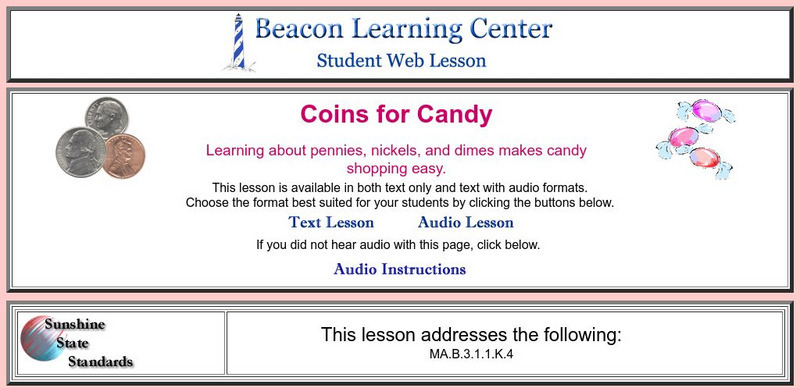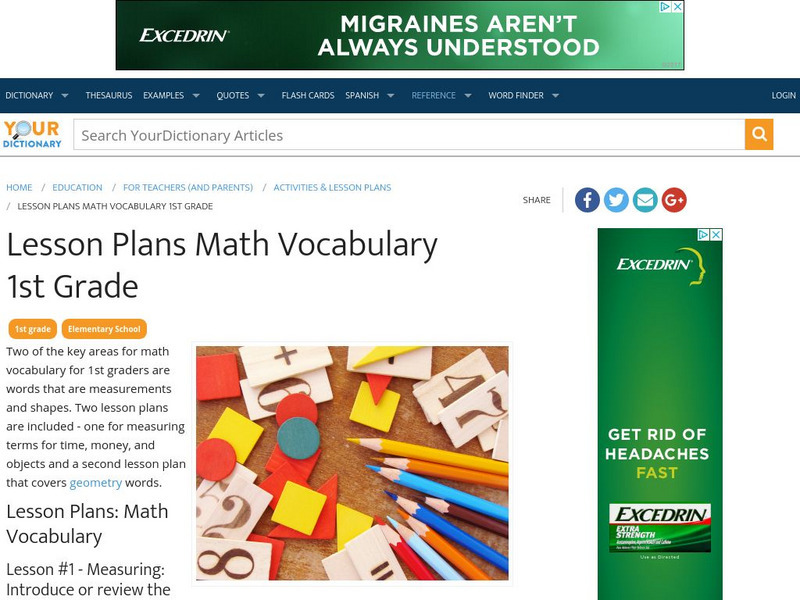Council for Economic Education
Econ Ed Link: No Funny Money, Honey I Want the Real Thing!
Do you know what funny money is? It's NOT the real thing! Find out how our government tries to make our money hard to copy in this lesson about real and fake money.
Crayola
Crayola: Money in the Bank
Young bankers and storekeepers practice counting money and making change. They keep their money in this recycled-box bank.
Better Lesson
Better Lesson: Time and Money
As the result of a Unit assessment, it was found that students showed some confusion with writing time and with adding sets of coins. These skills need to be reviewed to aid in mastery of the Common Core standards for time and money.
Better Lesson
Better Lesson: More Dimes and Dollars
Second graders need practice using coins and dollars and relating them to ones, tens and hundreds. Common Core standards include counting by 10s and 100s.
Other
Nearpod: Word Problems: Money
For this lesson on money word problems, 2nd graders learn about the different coins, explore skip counting on number lines, and apply their learning to a real-world scenario.
Better Lesson
Better Lesson: Fractions of Time and Money
People talk about quarters of the hour, or quarters in a dollar. This lesson lets students in on what that means.
Scholastic
Scholastic: Study Jams! Math: Compare Money Amounts
This interactive lesson teaches how to compare money amounts step by step.
Scholastic
Scholastic Lesson Plan: A Chair for My Mother
This extensive lesson plan uses the Children's Literature book "A Chair for My Mother," by Vera B. Williams to teach the concepts of saving and reaching a goal. Primary students are the target for this lesson.
Practical Money Skills
Practical Money Skills: Lessons: Pre K Grade2
Four lessons on basic money skills for young learners cover topics such as identifying money, spending money, and earning money.
Alabama Learning Exchange
Alex: Show Me the Money
For this lesson, young scholars identify coins, describe their attributes, learn their value, and count like coins. Students view an interactive web lesson that provides practice. Concepts are taught using songs, poems and games. This...
Scholastic
Scholastic: Adventures in Math: Lesson 2: Money Planning
What can we do with money? Deciding on the best use of our money requires planning. Students will identify ways that money can be used: spending, saving, and giving.
Scholastic
Scholastic: Adventures in Math: Lesson 1: Money Basics
Why do we use money? Learn why we need money and to identify bills and coins.
Other
My Schoolhouse: Counting Money: Coins
Interactive lesson teaches students how to count coins. Students can practice the skill and check their answers.
Beacon Learning Center
Beacon Learning Center: Coins for Candy
An interactive lesson helps students identify, compare, and learn the value of coins including pennies, nickels, and dimes.
Practical Money Skills
Practical Money Skills for Life: Lesson Plans
A series of financial literacy lesson plans broken out by grade range for grades from Pre-K through college, with an additional set of lessons created for students with special needs.
Scholastic
Scholastic: Adventures in Math: Lesson 3: Money in Our Community
Lesson focuses on how and why money circulated within our community. Being able to discern the difference between things we need and things we want is one of the foundational concepts for using money wisely. Goods and services are things...
Practical Money Skills
Practical Money Skills: Making Spending Decisions
This lesson introduces guided, money-related, decision-making activities for children in preschool and kindergarten.
Scholastic
Scholastic: Adventures in Math: Lesson 1: Money Matters
The process of earning money is the cornerstone of financial literacy. In this activity, students will identify key terms associated with earning money, explore ideas for earning money now, and evaluate various career options as sources...
Scholastic
Scholastic Instructor: A Pocketful of Gold?
Learn more about the Susan B. Anthony silver dollar, the Sacagawea coin, and other coins through this resource.
University of Missouri
University of Missouri: Wise Pockets: Four Dollars and Fifty Cents
This is a lesson geared towards elementary level students. Using the book Four Dollars and Fifty Cents by Eric Kimmel, the teacher instructs students about the terms creditor, debtor, collateral, credit, and credit report. Lesson...
Better Lesson
Better Lesson: Identifying Coins
Find a lesson here to help students learn more about money that is all around them! Give them the chance to review coin identification with the coin game and practice.
Better Lesson
Better Lesson: Hundreds, Tens, Ones Are Coins Too
Second graders will extend their understanding of hundreds, tens and ones using dollars, dimes and pennies as another way to express groups of 100, 10 and 1.
Love To Know Media
Your Dictionary: Lesson Plans Math Vocabulary 1st Grade
This site includes two first grade math vocabulary lesson plans: one for measurement terms and time and money, and another for geometry terms
Better Lesson
Better Lesson: Getting Paid for Our Work
Second graders see how money is used to buy and sell items. They will participate in an activity to see how people get money.
Other popular searches
- Money Lessons Giving Change
- Counting Money Lessons
- Canadian Money Lessons
- Second Grade Money Lessons
- 2nd Grade Money Lessons
- Australian Money Lessons
- Shopping Money Lessons
- Math Money Lessons
- Money Lessons Elementary
- Fun Money Lessons
- Counting Money Math Lessons
- Adding Money Amounts Lessons














